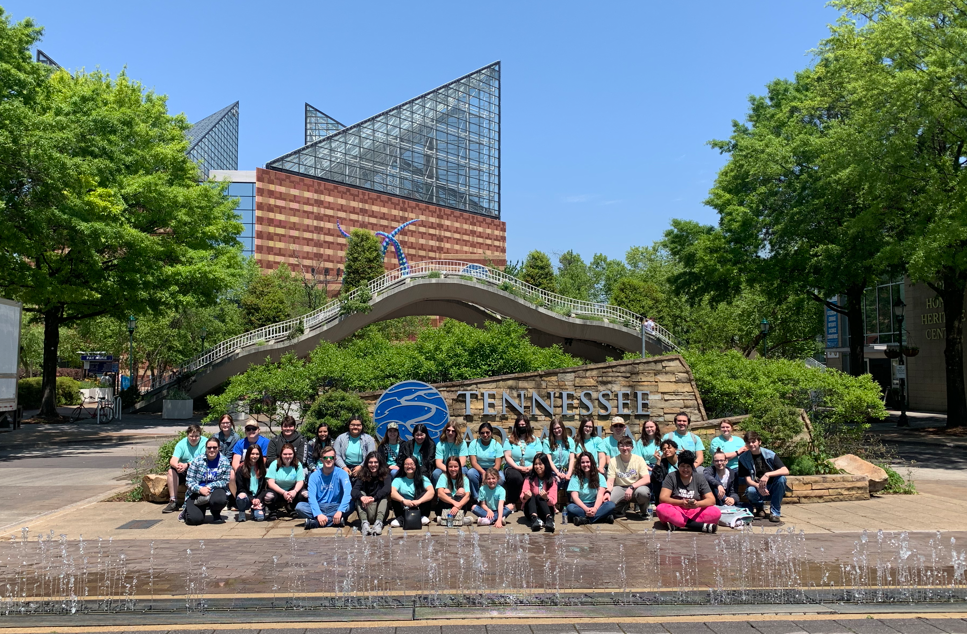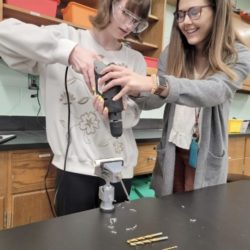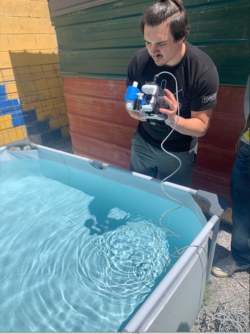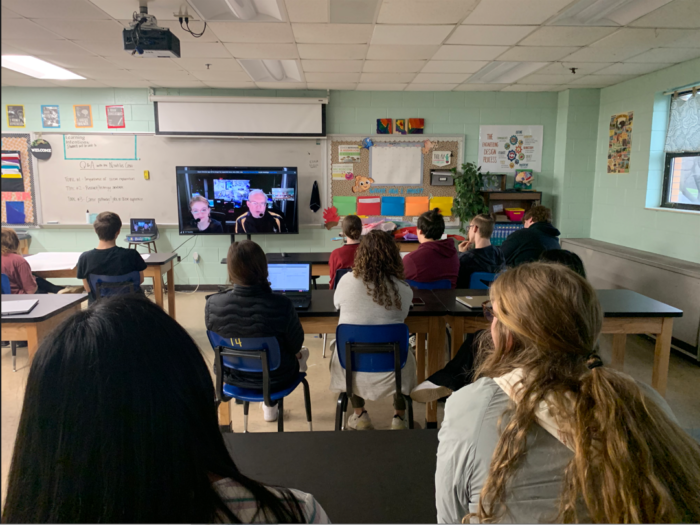
Butler County High School Dives Deep into Marine Biology

Butler County’s Marine Biology class and STEM Club visit the Tennessee Aquarium to bring their studies to life. Photo credit: Emily McAfee
Butler County High School received grant funding from the National Marine Sanctuary Foundation and NOAA Ocean Exploration to build capacity for ocean literacy and STEM workforce development in their community. Their project, titled “Diving Deep into Marine Biology,” provided students in rural Kentucky with a unique experience that combined traditional marine science content knowledge with hands-on experiences and exposure to career opportunities in the field. Over the course of the spring semester, students in Ms. McAfee’s class learned about marine ecosystems, seasonal ocean processes, biodiversity, and human impacts. Each unit included opportunities for students to apply what they learned through a STEM activity. Highlights included laser printing bathymetric maps of explored seamounts, the design, build, and testing of remotely operated vehicles using the SeaPerch (ROV) curriculum, and Skyping scientists and explorers on board Ocean Exploration Trust’s Exploration Vessel (E/V) Nautilus! In the end, students not only gained knowledge about the ocean environment, they also left with an awareness of the diversity of positions that support ocean exploration. We spoke with Ms. McAfee to learn more about their project.

Educator Emily McAfee (right), guides a student using a drill for the first time to drill holes in PVC pipes that will be used to create the ROV. Photo credit: Emily McAfee
What do you teach? Where? For how long?
Currently, I have the privilege of teaching Biology and now Marine Biology at Butler County High School, located in south-western Kentucky. I began my first teaching job teaching here in January of 2020, just prior to the pandemic. Butler County is, as you might guess, considerably rural and far-removed from the ocean. That is why after two years of teaching Biology, I was ecstatic about the opportunity to offer a Marine Biology course for our BCHS students.
Is this your first grant? How did you hear about it?
This is the first grant I have applied for and received for my classroom. I knew I wanted this course to be a unique experience for my students so I began searching for inspiration, namely from educators like me. I heard about the grant via word of mouth when a fellow marine science teacher shared the grant application via a Facebook group named, “National High School Marine Science Teachers.””.

A senior at BCHS examines ROV after its first test run in the water. Photo credit: Emily McAfee
How did you come up with your project idea – what were the needs you saw at your school?
I came up with the project idea by examining how I could best make Marine Biology tangible and in reach for my students. With our district being roughly 350 miles away from the ocean, generating a project that was within our reach proved to be challenging. But one constant need in any science classroom is to expose students to careers and possibilities that await in the STEM field. I wanted to create a project that made marine science tangible for our students and that meant getting them hands-on experiences of what a career in this field could look like. Our project did just that. While learning about marine science students were exposed to various technologies that are used in today’s exploration of the ocean. Students could explore these technologies without having to be near the ocean. Bathymetry for sea-floor mapping and ROV technologies are crucial to the further exploration of our expansive ocean so it seems obvious to me why we should spend time investing in exposing students to these technologies. Students were able to fine-tune the skills necessary to create 3-dimensional Bathymetric maps and engineer a submersible ROV (Remotely Operated Vehicle) that could effectively, at least in theory, be used to monitor and explore new ecosystems. This project was a beautiful way to integrate all aspects of STEM, as it melded engineering, technology and mathematics directly to marine science.
Major outcomes (overall, highlight anything that surprised you or wasn’t expected)
Something that surprised me was how adaptive this project required me to be as an educator. With a project like this I had to learn alongside my students and be flexible. This was the first time I have done an engineering project in my classroom and I was surprised at how difficult it was for me to relinquish control. In my experience, students learn best without the constraints and more opportunities to build on their creativity.

Completed ROV with waterproofed motoring, wires, and design that students purposefully created through the engineering design process. Photo credit: Emily McAfee
How did the grant improve/aid your curriculum and/or students’ experience?
As previously mentioned, I believe the greatest impact this grant has had on my Marine Biology curriculum is the pathway it gives my students to explore careers in marine science. We encourage students to pursue careers in STEM throughout grade school but when it comes down to it students rarely understand all of the available opportunities in the field. It is often not until these students reach college or post-grad work that they are exposed to different fields or career opportunities that interest them, and this I believe, is a disservice to our students. That is why this project has been such a great installment into our marine biology curriculum. One student, a senior at Butler County High School, went into this course knowing he wanted to be a marine biologist after high school and planned to pursue a degree in Aquatic Biology. While this degree will help him pursue his goals, this student graduated with a broader outlook on the possible career opportunities that await him after graduation and even alternative pathways to get him there based on pursuing various interests thanks to this project.
In our preparation for our ROV project my students planned a Q&A session with the team members of the Exploration Vessel Nautilus, a vessel dedicated to ocean exploration. The E/V Nautilus ship is abundant in scientists with diverse educational/career backgrounds that are pursuing exploration through seafloor mapping and ROV expeditions, in hopes of new discoveries in biology, archaeology and geology. There are engineers dedicated to the maintenance and continual improvement of the ROV’s on ship, geologists who specialize in interpreting samples of rock and sediment, ROV pilots, data loggers, seafloor mappers and more. My students were shocked at the diversity of jobs on the ship and the various background crew members had. This experience expanded my students’ view of a “marine biologist” and how they could pursue a career in this field. The student mentioned above is now hoping to take advantage of the Science and Engineering Internship by applying to the program for the summer of 2023. This grant improved my curriculum by broadening my students’ outlook on the STEM field by making it relevant, engaging and most importantly attainable for these students.
Any words of encouragement / parting advice for other teachers that want to do this?
As a fellow educator, I understand the importance of time, and the grant writing process produces hesitation in teachers due to that respect. As a teacher our time is valuable and it is disheartening to think that you could spend valuable time brainstorming ideas and writing a proposal for a project that you might not even get the chance to carry out. My advice? Take the risk. The benefit your students will reap, potentially for a lifetime, far outweighs the loss of losing some of your personal time. That is not to say your time is not valuable but rather to find something you are passionate about. I believe this organization will recognize passionate teachers and potential projects with an eagerness, not to miss out on an opportunity to make an impact in your classroom. My last piece of advice for anyone considering applying for this grant is to find a support team. I owe much of the success of this grant to my department who supported me each step of the way, through the creation of ideas for the project all the way through the completion of this project. If you don’t already have that support team, find others who share the same passion or are going through the same process.

Marine Biology class is shown zooming with the crew of the Nautilus, where they shared information about their technology on board, recent expeditions and shared the various career pathways scientists on board took to get there. Photo credit: Emily McAfee
